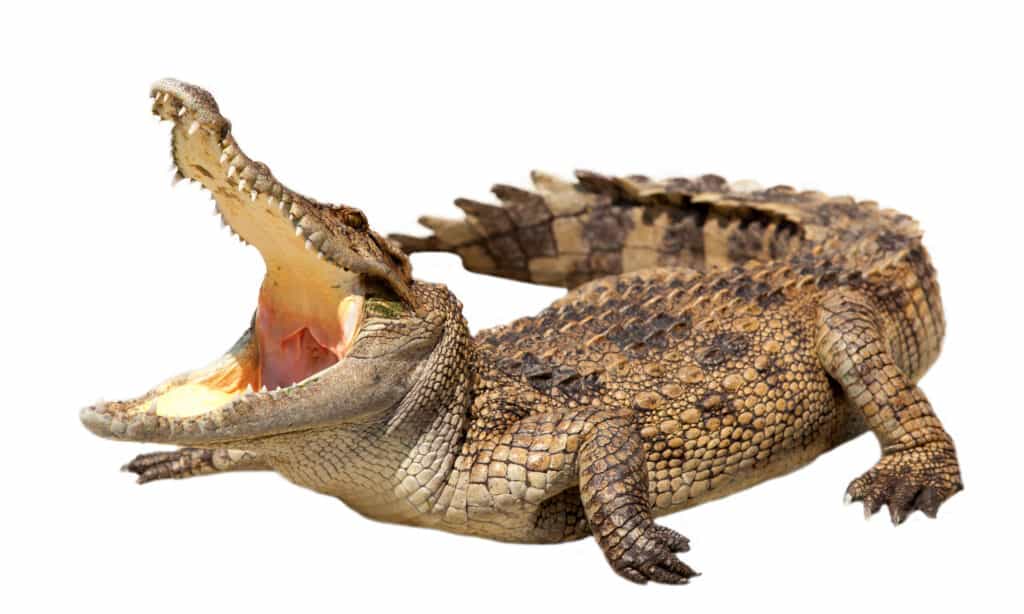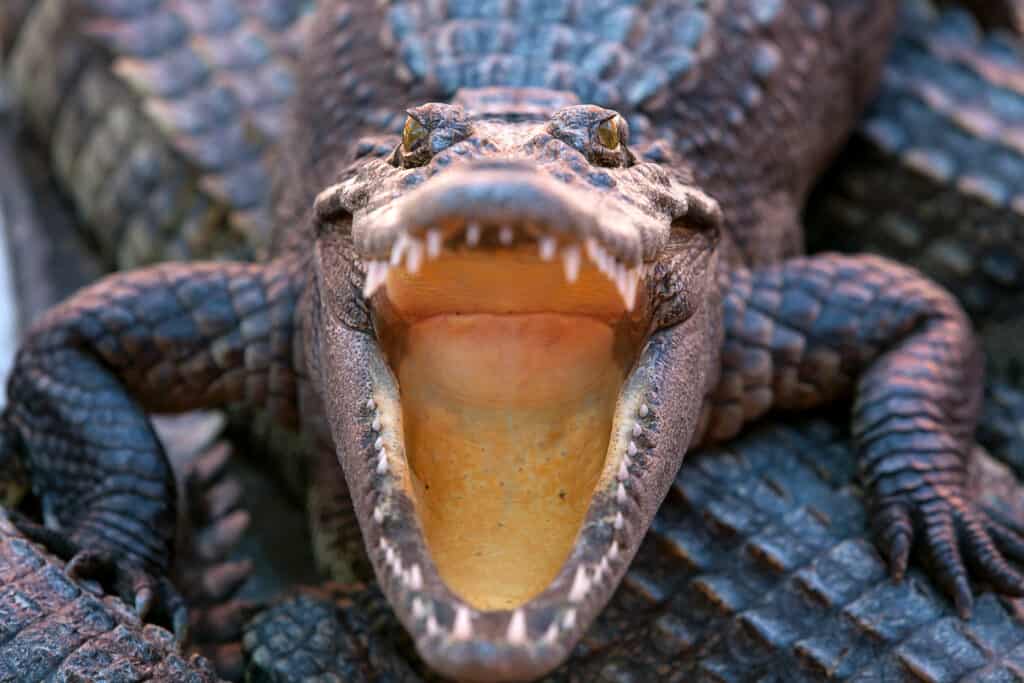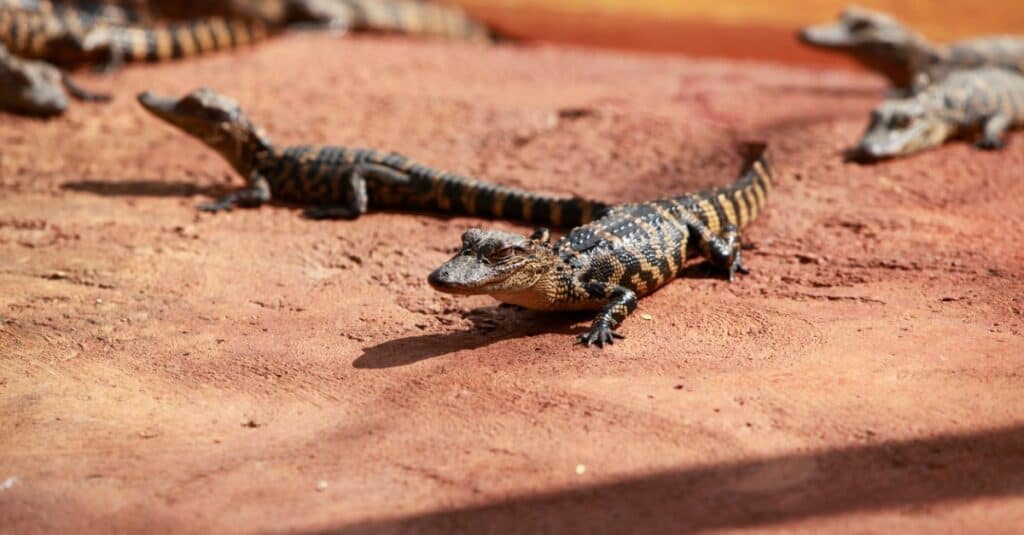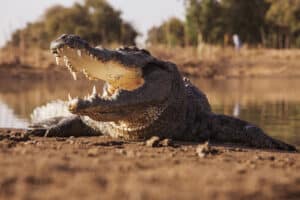Crocodiles live in the tropics of Asia, Africa, Australia, and the Americas. They are members of the order Crocodilia, which includes alligators, and caimans. Crocodiles can be quite terrifying in appearance, along with the fact that they move fast in the water. In fact, they swim up to 22 mph! Their muscular tails and webbed feet serve as rudders to aid their speed.

Let’s look at 10 more incredible facts about crocodiles!
1. Crocodiles And Dinosaurs Are Related

Dinosaurs and crocodiles came from the same crown group.
©iStock.com/AppleZoomZoom
Crocodiles are a type of reptile; however, they are more closely related to dinosaurs and birds than to other reptiles. First, crocodile-like organisms appeared on Earth about 240 million years ago. This means they existed around the same time as dinosaurs! The first crocodiles were around three feet in length, stood (and walked) on two feet, and did not evolve into their modern form until much later. Their front legs are considerably shorter than their rear ones.
2. The Words “Crocodile Tears” Actually Comes From Crocodiles

The term “crocodile tears” really comes from crocodiles.
©iStock.com/underworld111
“Crocodile tears” are known as fake tears. This phrase refers to the way crocodiles cry when eating. As they swallow, air from their sinuses enters the tear ducts and overflows out of the eyes, making them appear to cry even though they are not. Crocodiles also huff and hiss when feeding, causing their eyes to water. Thus, crocodile tears!
3. Crocodiles Have The Strongest Bite Of Any Animal On The Planet!

Crocodiles have the strongest bite on the planet.
©iStock.com/nattanan726
The maximum pressure a human jaw can exert per square inch is only 100 pounds. In contrast, according to our knowledge of crocodiles, their jaws can exert 3700 pounds of pressure per square inch. In comparison to a great white shark, it has a bite that is ten times more potent. However, the crocodiles’ jaw-opening muscles are so tiny and feeble that a person may close their mouth with simply a rubber band or his or her hands.
4. Baby Crocodiles Make Noises Inside Their Eggs Before They Hatch

Baby crocs make noises from inside their shell!
©iStock.com/Casanowe
Another fascinating characteristic of crocodiles is that young crocodiles signal to their moms when they are prepared to hatch properly. The mother will hear the baby’s tiny noises coming from inside the eggshell, which is frequently covered in sand. The mother crocodile will then remove the eggs from the sand, protect the young until they are born, and bring them to the river so they can feast on insects.
5. Crocodiles Are The Biggest Reptile Known On Earth

Saltwater crocodiles are the largest crocodile species and also the largest living reptile in the world.
©iStock.com/PomInOz
In terms of overall length, saltwater crocodiles are the largest living reptiles on earth. Adults can grow to more than 23 feet, making them the world’s longest reptiles. They have been known to attain weights of up to 5000 kilograms, which is up to 2600 pounds!
6. Crocodiles Have 24 Teeth That They Never Use To Chew

Crocodiles are apex predators who only use their teeth to snag and break their dinner.
©nattanan726/Shutterstock.com
Although they have 24 incredibly sharp teeth, crocodiles hardly ever use them to devour their food. Instead, they use their teeth to capture, grab, and shatter their prey or food. They swallow tiny stones that, in their stomachs, grind up food for them. Their jaws can also exert a lot of effort when they close, but minimal force is needed to keep them shut.
7. The Temperature Of A Crocodile Egg Can Determine The Gender Of The Baby

88.8 degrees is the magic number for male crocodiles.
©Tomas Ragina/Shutterstock.com
The egg of a male crocodile hatches at a temperature of 88.8 ℉. If the temperature is either higher or lower than this threshold, the egg of a female crocodile will hatch!
8. Crocodiles Sometimes Rest With Wide-Open Mouths

Sometimes crocs rest with their mouths open to improve ventilation.
©iStock.com/AppleZoomZoom
Don’t freak out right away if you spot a croc with its mouth wide open. When confronted with a crocodile in such a manner, most individuals automatically fear for their safety. However, the majority of the time, they are merely resting like this. The reason they do this is to improve their ventilation. Because crocodiles are unable to sweat, they must open their jaws to dissipate body heat.
9. Crocodiles Sometimes Swallow Small Stones To Help With Digestion

Rocks in crocodiles’ stomachs aid in digestion.
©Artography/Shutterstock.com
Animals with shells and bones or crocodiles that consume their prey whole benefit from swallowing stones called “gastroliths.” Food is ground in their stomachs with the aid of gastroliths. The crocodile’s stomach can harbor these stones for many years.
10. 99% Of Baby Crocodiles Are Consumed In Their First Year

99% of baby crocodiles die within their first year.
©iStock.com/Murmakova
Unbelievably, these fearsome predators are quite vulnerable when first born. In fact, infant mortality is extremely high in most young crocodiles, reaching up to 99% of them dying before completing their first year of existence. Most of them are consumed in their first year by various predators, including adult crocodiles, lizards, hyenas, and even large fish. Unfortunately, some people also relish eating crocodile eggs.
The photo featured at the top of this post is © iStock.com/AppleZoomZoom
Thank you for reading! Have some feedback for us? Contact the AZ Animals editorial team.







